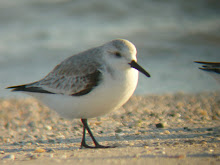One should notice, by the way, how low my standards are after a long and cold Michigan winter. I are not daydreaming here about exotic, nemesis species, such as worm eating warblers, clay colored sparrows, or bachman warblers, no! Just a cute, common, yellow warbler (ok let's say a male), is all I can dream about right now.
But last Sunday, the warm days were looking as distant from Michigan as a growing economy. Temperature, again, fell in the single digits (in Farenheit, unfortunatly), despite the bright sun.

Ice skater in Gallup Park

Icicles around tree branches
Decided to make the most of the situation, I walked quickly along the bike path, scanning for waterfowls. Nothing much new there, except an American Coot (FOY), and a growing number of Hooded and Common Mergansers. 6 Goldeneyes were diving along the ice, and a dozen Buffleheads were also seen. Interesting was the fact that 2 males Goldeneyes were already fighting , despite having 4 females available. Maybe greediness is not only a human sin after all
I flushed a winter wren (FOY, First Of year!), and discovered 2 Trumpeter Swans. These swans were quite cooperative, and I was able to take pictures of them without using my digibinsing technique. Not too surprisingly these are much sharper than usual, and I am proud to relieve my regular readers (the three of them!) from their chronic headaches caused by the usual blurriness of my digibinsed pictures.
This gives me an excellent opportunity, using my old pictures from Lake Erie Metro Park, to study the differences between the Tundra and Trumpeter Swan. Being a beginner (my first birding outing was in January 2007 with my friend and birding mentor Jochen, in...Gallup Park), I struggled so far to make the distinction between the two species, so now it is about time to solve this problem for good. A picture being worth a thousand words (5 pictures = 5000 words?), I tried to match pictures of the two species in a somehow similar position. A reader looking for quality and accuracy should probably stop at this point, and look at the excellent description made by David Sibley.
- From the front (look at the V shape border for the Trumpeter, U shape for the Tundra)

Trumpeter Swan (Cygne Trompette)

Tundra Swan (Cygne Siffleur)

Trumpeter Swan, detail
- From the side : (look at the broadly connected eye of the trumpeter, versus the almost separated Tundra Swan eye)

Trumpeter Swan

Tundra Swan, detail
It should be noted that the yellow lores that are usually present (I've read 90% on other blogs) on most Tundra swans are not showing on my digiscoped pictures. This is likely due to the poor quality of my pictures, but I guess this is a hint that we should not take this feature for granted.
At last, I should end this post with the last swan present in michigan, usually fairly easy to identify to the attentive birder.... The Mute Swan (for the inattentive or distracted reader, look at the color of the bill...)

Mute Swan (cygne tubercule), present on Gallup Park last Sunday
Not too hard most of the time....but what's about this one?






3 comments:
What a cool Swan!!
That pic showing the detail is awesome, great for learning when there is no chance to see the actual bird :)
You got some great shots that are most useful for identification. You might enjoy the detailed section of our website on i.d. of North American swans and the printable i.d. brochure you can take in the field. We have a wealth of information on Trumpeter Swans www.trumpterswansociety.org - enjoy! We also have a Blog trumpeterswansociety.wordpress.com
Thanks Mel! I only wish I had a good picture of a Tundra!
Trumpeterswansociety : thanks for your comment. I'll check your website and blog!!!!!!
Post a Comment